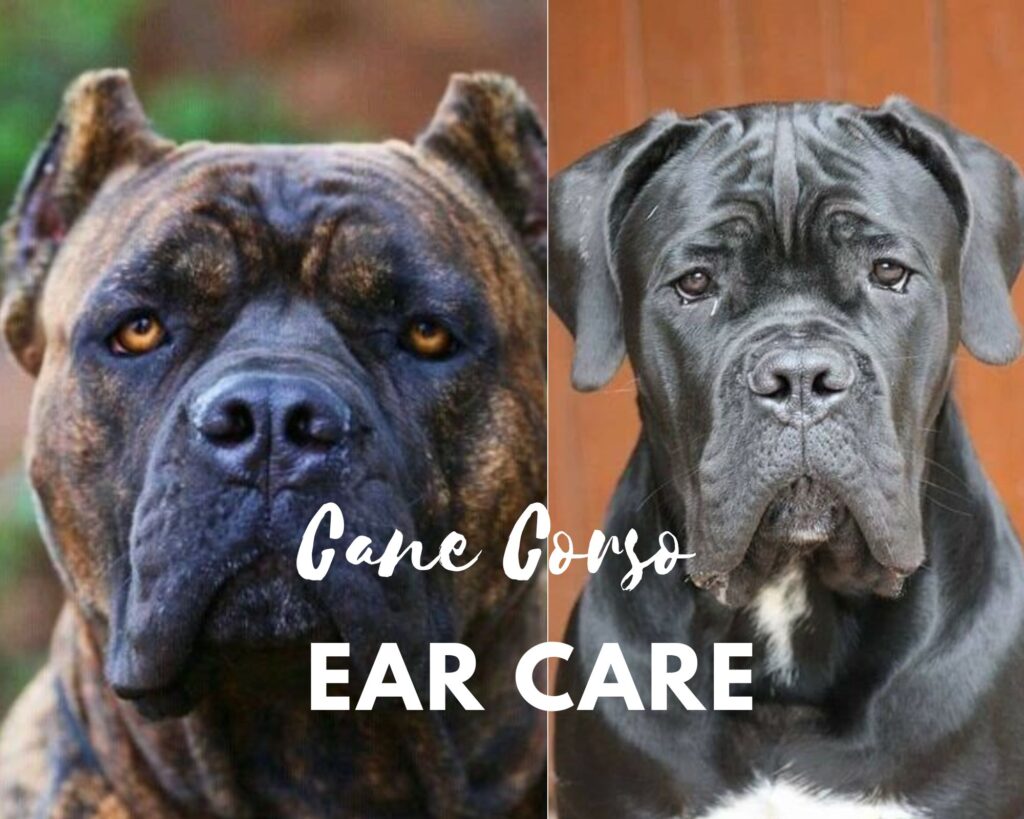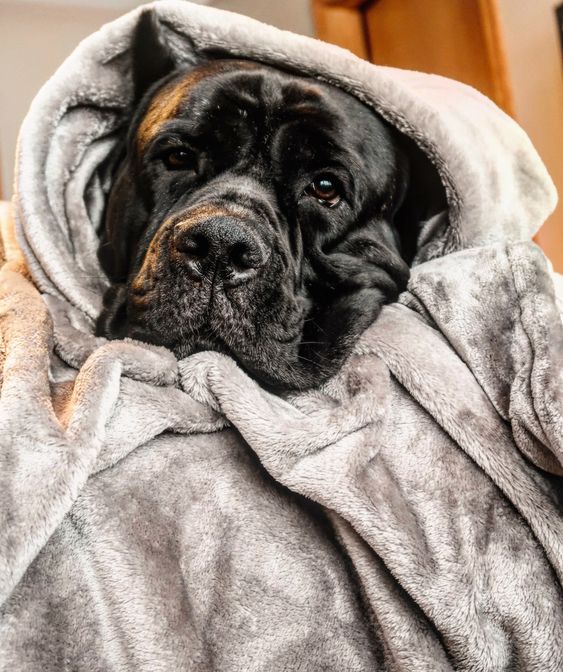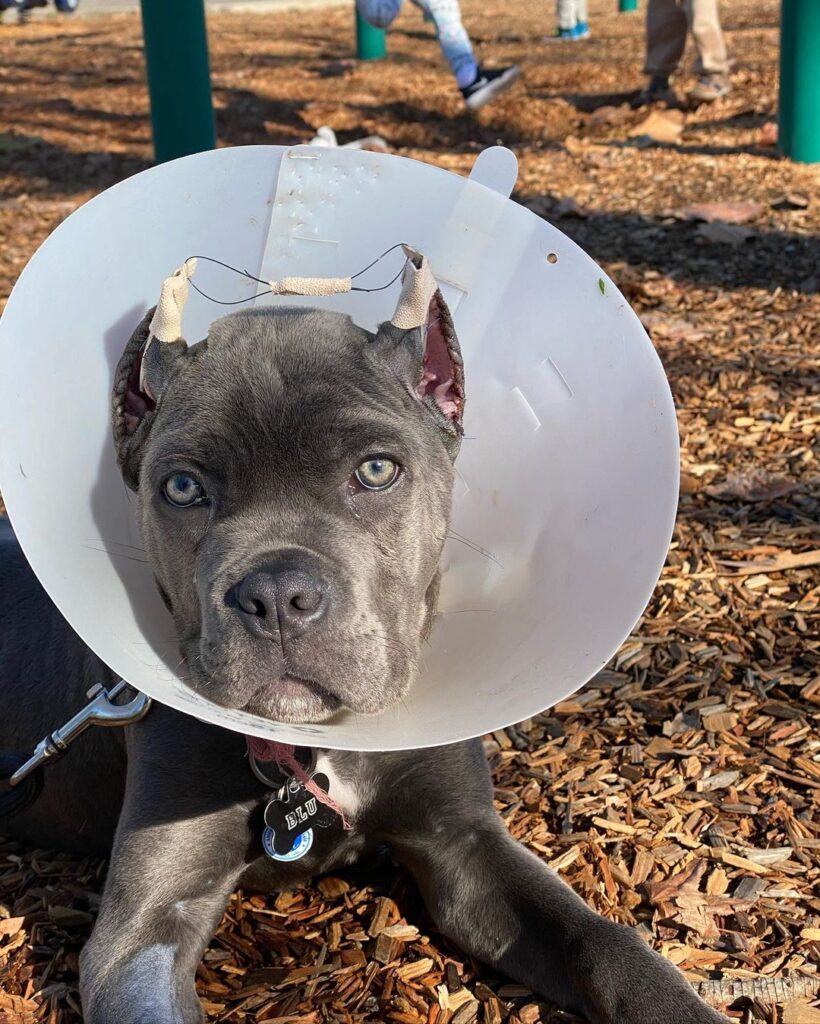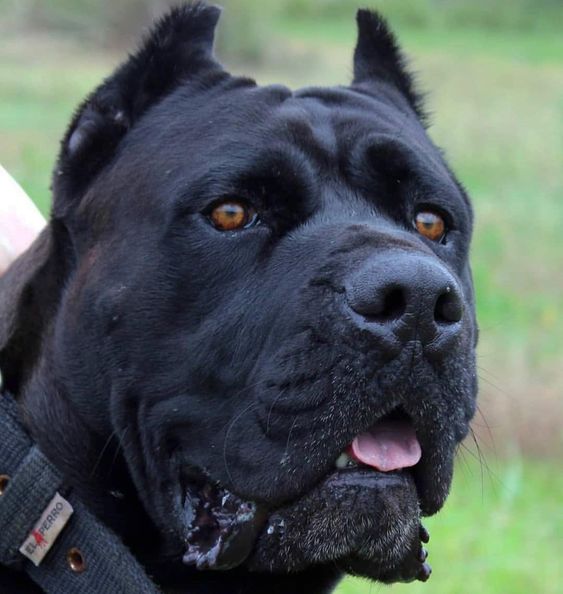
The Cane Corso is a magnificent breed known for its strength and loyalty. To ensure your Cane Corso lives a healthy and happy life, it’s crucial to pay special attention to their ear care. Whether your Cane Corso has cropped or uncropped ears, this guide will provide you with valuable insights on maintaining their ear health.
Why Cane Corso Ear Care Is Important
When it comes to your beloved Cane Corso, their well-being is of the utmost importance. One aspect of their health that often goes overlooked is ear care. But why is it so crucial? The answer lies in the profound impact ear health has on your dog’s overall quality of life.
Cane Corsos, with their strong and muscular bodies, might not seem like they would have delicate ears. However, their ear structure is more intricate than meets the eye. Understanding this anatomy is the first step in comprehending why ear care is essential.
The Anatomy of Cane Corso Ears
Cane Corsos possess ears that are not just part of their aesthetics; they play a significant role in their daily lives. These ears are composed of complex structures designed to capture and funnel sounds, enabling them to perceive the world around them with remarkable acuity.
Inside those striking ears are delicate components like the ear canal, eardrum, and a labyrinthine network of bones and tissues. The ear canal, for instance, can be a haven for moisture, debris, and bacteria, making it a potential breeding ground for infections.
Understanding the function of these intricate ear structures helps you appreciate the importance of proper ear care. An infection or irritation in any part of this system can lead to discomfort, pain, and, in severe cases, even hearing loss for your Cane Corso.
Furthermore, ear health goes beyond just auditory function. Healthy ears contribute to your dog’s overall well-being. Untreated ear issues can cause stress, discomfort, and a decrease in the quality of life for your furry friend. This is why investing time and effort in Cane Corso ear care is not just a matter of aesthetics; it’s a fundamental aspect of responsible pet ownership.
Cane Corso Cropped Ear Care
Cane Corso cropped ears can give this majestic breed a distinctive and imposing appearance. However, with this unique aesthetic choice comes added responsibility—ensuring the health and well-being of your dog’s cropped ears. To keep your Cane Corso’s ears looking sharp and infection-free, it’s vital to understand the cropping process and adopt the right cleaning techniques.
The Cropping Process
Ear cropping is a surgical procedure where a portion of the ear flap is removed, leaving the remaining section upright. Historically, this practice was employed for various reasons, including working dogs’ safety. While ear cropping is a personal choice and not medically necessary, understanding the process is essential if you decide to go through with it.
The cropping process typically occurs when a Cane Corso is around 7 to 12 weeks old. A veterinarian with expertise in ear cropping performs the procedure, which involves anesthesia to ensure the pup’s comfort. Afterward, the ears are bandaged and require diligent post-operative care.
Cleaning Cropped Ears
Proper cleaning is paramount for the health of cropped ears. The post-operative period is particularly critical, as the incisions need to heal without complications. Cleaning should be done with care and attention to detail.
Start by using a veterinarian-recommended ear cleaning solution. Gently soak a clean cotton ball or gauze pad in the solution, being cautious not to rub or press on the healing incisions. Gently clean the visible parts of the ear flap, taking care to remove any dried blood or discharge.
The key to successful cleaning of cropped ears is to be gentle and avoid causing any pain or discomfort. If you notice any signs of infection, such as redness, swelling, or a foul odor, contact your veterinarian immediately.
While cropped ears can give your Cane Corso a striking appearance, they also require commitment and care. Regular cleaning and vigilant monitoring can help prevent complications and ensure that your dog’s ears remain both impressive and infection-free. In the following sections, we’ll explore in more detail how to clean cropped ears and address any potential issues that may arise.
Cane Corso Uncropped Ear Care
For Cane Corso owners who opt for the natural look, uncropped ears are a defining feature of this magnificent breed. While natural ears may not require the same surgical aftercare as cropped ones, they still demand attention and care to ensure your dog’s ear health. Let’s explore the world of Cane Corso uncropped ear care, focusing on natural maintenance and infection prevention.
Natural Ear Maintenance
The beauty of uncropped ears lies in their simplicity. These ears are left in their natural, floppy state, which means they don’t require the post-operative care associated with ear cropping. However, this doesn’t mean they are maintenance-free. In fact, proper natural ear care is vital for preventing common issues and discomfort.
Start by routinely inspecting your Cane Corso’s ears. Look for signs of dirt, debris, or redness. Regular inspections allow you to catch problems early and take preventative measures. Gently clean the visible parts of the ear using a veterinarian-recommended ear cleaning solution and cotton balls. Avoid inserting anything into the ear canal to prevent injury.
Preventing Infections
Preventing ear infections is a primary goal in Cane Corso uncropped ear care. While natural ears may have fewer issues compared to cropped ones, they are not immune to infections or irritations. Here’s how to keep your dog’s ears healthy:
Regular Cleaning: Cleaning your dog’s ears helps remove dirt and excess wax. Use a dog-specific ear cleaner and follow the instructions carefully.
Allergen Control: Identify and minimize potential allergens that may affect your dog’s ears. Common allergens include pollen, dust, and certain foods. Consult with your veterinarian if allergies are suspected.
Dietary Considerations: A well-balanced diet plays a significant role in overall ear health. Ensure your Cane Corso is on a diet rich in essential nutrients.
Veterinary Consultations: Regular vet check-ups are essential for early detection of any ear-related issues. Your veterinarian can provide guidance on preventative care and address concerns promptly.
By incorporating these practices into your Cane Corso’s care routine, you can enjoy the natural beauty of their uncropped ears while ensuring they remain healthy and infection-free. In the following sections, we will dive deeper into the signs of ear problems and how to address them, providing you with the knowledge to be a responsible and attentive Cane Corso owner.
Common Ear-Related Issues
In the world of Cane Corso ear care, understanding and being vigilant about common ear-related issues is essential for ensuring your furry friend’s comfort and well-being. While Cane Corsos are generally robust dogs, their ears can sometimes become a source of discomfort or pain. Let’s explore two of the most prevalent ear-related issues: ear infections and allergies.
Ear Infections
Ear infections are a common concern for many dog breeds, including Cane Corsos. These infections can be uncomfortable and even painful for your canine companion. Recognizing the signs of an ear infection is the first step in addressing the issue promptly.
Common signs of an ear infection include constant head shaking, scratching at the ears, redness or swelling in the ear canal, a foul odor emanating from the ears, and the presence of discharge. If you notice any of these symptoms, it’s crucial to consult your veterinarian promptly.
Ear infections can be caused by various factors, including bacterial or yeast overgrowth, allergies, foreign objects in the ear, or excessive moisture. Your vet can determine the underlying cause and recommend appropriate treatment, which often includes medication, ear cleaning, and potential dietary adjustments.
Allergies and Sensitivities
Cane Corsos, like other dogs, can be susceptible to allergies and sensitivities that can manifest in ear issues. Allergies can be triggered by environmental factors such as pollen, dust mites, or specific foods. Sensitivities to certain materials, like cleaning products or grooming supplies, can also lead to ear problems.
Identifying allergies and sensitivities is crucial for managing ear health. Symptoms may include excessive itching, redness, swelling, or even hives. To address these issues, consult with your veterinarian to determine the allergen or sensitivity causing the problem.
Managing allergies often involves allergen control, such as keeping your dog away from known triggers, like pollen, or switching to hypoallergenic cleaning products. In some cases, dietary adjustments may be necessary. Your veterinarian can recommend specialized diets or supplements to alleviate allergic reactions.
How to Prevent Any Ear-Related Issues in a Cane Corso
Proactive prevention is the key to ensuring your Cane Corso enjoys a life free from ear-related problems. By incorporating a few simple practices into your dog’s care routine, you can minimize the risk of ear infections, allergies, and discomfort. Let’s explore these preventive measures to keep your Cane Corso’s ears in optimal health.
| Ear-Related Issue | Symptoms | Potential Causes |
|---|---|---|
| Ear Infections | Head shaking | Bacterial or yeast overgrowth |
| Scratching at ears | Moisture or trapped debris in the ear canal | |
| Redness or swelling | Allergies or sensitivities | |
| Foul odor or discharge | Foreign objects in the ear | |
| Allergies and | Excessive itching or scratching | Environmental allergens (pollen, dust) |
| Sensitivities | Redness or swelling | Food allergies or sensitivities |
| Hives or rash | Contact with irritants (cleaning products, grooming supplies) |
Regular Ear Inspections
The first line of defense against ear-related issues is regular ear inspections. By routinely examining your Cane Corso’s ears, you can catch any potential problems early, before they escalate. During these inspections, look for signs of redness, swelling, discharge, or excessive wax buildup. If you notice anything unusual, consult your veterinarian promptly.
To make inspections more comfortable for your dog, associate them with positive experiences, like treats or playtime. This will encourage cooperation and reduce anxiety during the process. Regular inspections help you identify and address issues before they become major concerns.
Proper Ear Cleaning Techniques
Ear cleaning is a fundamental aspect of Cane Corso ear care. To prevent infections and discomfort, it’s essential to clean your dog’s ears properly. Start by using a veterinarian-recommended ear cleaning solution, which is designed specifically for canine ears.
Gently soak a clean cotton ball or gauze pad in the solution, being cautious not to insert anything into the ear canal. Gently clean the visible parts of the ear, removing dirt and excess wax. Remember, excessive cleaning can disrupt the ear’s natural balance, so stick to a regular schedule recommended by your vet.
Balanced Diet and Nutrition
What your Cane Corso eats plays a significant role in ear health. A balanced diet rich in essential nutrients can help prevent ear problems. Ensuring your dog receives the right vitamins and minerals can strengthen their immune system, making them less susceptible to infections and allergies.
Consult with a veterinarian or canine nutritionist to create a tailored diet plan for your Cane Corso. They can recommend specific foods or supplements that promote ear health and overall well-being.
Environmental Factors
Environmental factors can also impact your Cane Corso’s ear health. Manage allergens in your dog’s living environment, particularly if they have allergies. Keep their living space clean, use hypoallergenic cleaning products, and provide a designated area for outdoor play to reduce exposure to potential allergens.
When it comes to prevention, knowledge and consistency are your greatest allies. Regular inspections, proper cleaning techniques, a balanced diet, and attention to environmental factors can help you create a protective shield around your Cane Corso’s ears, ensuring they enjoy a life free from ear-related issues.
5 Steps Cane Corso Ears cleaning

Step 1: Gather Your Supplies
Before you begin cleaning, it’s essential to gather all the necessary supplies. This ensures a smooth and efficient cleaning process. Here’s what you’ll need:
- Ear Cleaning Solution: Choose a veterinarian-recommended ear cleaning solution designed specifically for dogs. Avoid using human ear cleaners, as they may not be suitable for your pet.
- Cotton Balls or Gauze Pads: These are gentle tools for cleaning your dog’s ears. Avoid using cotton swabs, as they can push debris deeper into the ear canal and potentially harm the eardrum.
- Treats or Rewards: Having some treats on hand can help make the cleaning process a positive experience for your dog and reinforce good behavior.
Step 2: Prepare Your Dog
Ensure your dog is comfortable and relaxed before starting the cleaning process. Here’s how to prepare your furry friend:
- Choose a Quiet Area: Find a quiet, well-lit space where you and your dog can be at ease without distractions.
- Use Positive Reinforcement: Offer treats or rewards to create a positive association with ear cleaning. Pet and praise your dog to reassure them.
Step 3: Inspect Your Dog’s Ears
Before diving into the cleaning process, take a moment to inspect your dog’s ears. Look for any signs of redness, swelling, discharge, or foul odor. If you notice any unusual symptoms or if your dog appears to be in pain, consult your veterinarian before proceeding with cleaning.
Step 4: Begin the Cleaning Process
Now that you’re ready to clean your dog’s ears, follow these steps:
- Apply the Ear Cleaning Solution: Hold your dog’s ear flap gently and lift it to expose the ear canal. Carefully squirt the recommended amount of ear cleaning solution into the ear canal. Ensure the solution is at room temperature to avoid discomfort.
- Massage the Base of the Ear: Gently massage the base of your dog’s ear for about 30 seconds. This helps distribute the cleaning solution and loosens any debris.
- Wipe Away Debris: Using a cotton ball or gauze pad, gently wipe away any visible debris, wax, or excess cleaning solution from the ear’s surface. Be cautious not to push debris further into the ear canal.
Step 5: Reward and Repeat as Needed
After the cleaning process, be sure to reward your dog with treats, praise, and affection. This positive reinforcement helps your dog associate ear cleaning with a pleasant experience.
The frequency of ear cleaning depends on your dog’s specific needs and any recommendations from your veterinarian. Some dogs may require more frequent cleaning, while others may need it only occasionally. Always consult with your vet for guidance on the appropriate cleaning schedule for your furry friend.
FAQs
1. How often should I clean my Cane Corso’s ears?
Answer: Cleaning frequency depends on your dog’s needs but generally ranges from once a week to once a month. Consult your veterinarian for a personalized schedule.
2. Can I clean my Cane Corso’s ears with regular human ear cleaning products?
Answer: No, it’s essential to use veterinarian-recommended dog ear cleaning solutions. Human products may not be suitable for canine ears.
3. Is ear cropping necessary for Cane Corsos?
Answer: Ear cropping is a personal choice and not a medical necessity. Uncropped ears can be kept healthy with proper care.
4. What are the signs of an ear infection in my Cane Corso?
Answer: Common signs include head shaking, ear scratching, redness, swelling, foul odor, and discharge. Consult your vet if you notice these symptoms.
5. Are there any specific dietary requirements to prevent ear problems?
Answer: A balanced diet rich in essential nutrients can help maintain ear health. Consult with a veterinarian or canine nutritionist for specific dietary recommendations.
6. Can I prevent allergies in my Cane Corso’s ears?
Answer: While you can’t guarantee allergy prevention, you can manage them through allergen control, proper cleaning, and potential dietary adjustments.
7. What should I do if my Cane Corso’s ear cleaning sessions seem painful for them?
Answer: Stop immediately if your dog shows signs of discomfort. Consult your vet for a professional cleaning or advice on less invasive methods.
8. Are there any natural remedies for ear care in Cane Corsos?
Answer: Natural remedies like coconut oil can be used with caution, but always consult your vet for guidance and potential allergies.
9. Can my Cane Corso swim with uncropped ears?
Answer: Yes, they can, but it’s crucial to dry their ears thoroughly after swimming to prevent moisture-related ear issues.
10. How do I know if my Cane Corso’s ear issues require a vet’s attention?
Answer: If you notice persistent or severe symptoms, such as bleeding, extreme discomfort, or a sudden change in behavior, consult your veterinarian immediately.
Conclusion
In the journey of caring for your beloved Cane Corso’s ears, we’ve explored the importance of ear care, the anatomy of their ears, and how to address both cropped and uncropped ear maintenance. We’ve delved into common ear-related issues, including ear infections and allergies, and discussed prevention strategies. Now, armed with knowledge and practical tips, you can embark on a path to ensure your Cane Corso enjoys a life of comfort and well-being.
With over 4 years of devoted companionship with my beloved Labrador Retriever, Robin, I have cultivated a deep understanding and expertise in all things canine. From training and behavior to health and well-being.


